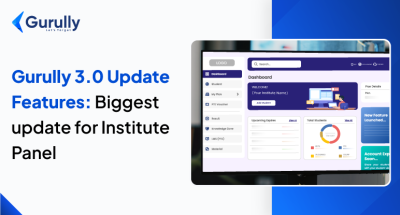English Proficiency Test have evolved significantly in recent years, with a growing trend towards computer-based exams. While traditional paper-based tests have been the norm for decades, the digital age has ushered in a new testing era, offering both advantages and challenges.
In this blog post, we will know the key differences between computer-based and paper-based English proficiency test, exploring their strengths and weaknesses to help you determine which format best suits your needs.
Computer-Based English Proficiency Test:
These tests are conducted on computers in a secure testing environment. Candidates interact with the test interface using a mouse and keyboard. The test format can vary depending on the specific test, but generally, candidates will see the questions and answer choices on the screen and select their answers using the mouse or keyboard.
Computer-based tests may incorporate multimedia elements such as audio recordings, video clips, and interactive graphics.
List of Computer-Based Exams
- PTE Academic – Academic study and immigration
- PTE Core – Immigration and work (mainly for Canada)
- IELTS Academic – Academic study and professional registration
- IELTS General Training – Immigration and work purposes
- TOEFL iBT – Academic study (mainly for North America)
- Duolingo English Test – Academic study and scholarship applications
- CELPIP (General and LS) – Immigration and work (for Canada)
Paper-Based English Proficiency Test
These traditional exams are administered in a physical test center. Candidates receive a test booklet with questions and answer sheets, and they respond to them using a pen or pencil.
Paper-based tests often involve filling in the blanks, matching words or phrases, writing short answers, and composing essays. Some paper-based tests may also include listening components, where test takers listen to audio recordings and answer questions on paper based on what they hear.
List of Paper-Based Exams:
- IELTS Academic – Academic study and professional registration
- IELTS General Training – Immigration and work purposes
- TOEFL Paper Edition – Academic study (where internet-based test is unavailable)
- OET (Occupational English Test) – Healthcare professional registration
Pros & Cons Of Paper-Based Mode of Exam
Pros:
- Familiarity: The traditional format of paper-based tests is widely recognized and can put test-takers at ease, reducing potential test anxiety associated with novel methods.
- Reliability: Paper-based tests provide a consistent and reliable testing environment, free from the potential glitches and technical difficulties inherent in computerized systems.
- Tactile Learning: Some individuals find processing information easier and solving problems with physical materials, such as writing or drawing on paper.
Cons:
- Time-Consuming: The administration, scoring, and analysis of paper-based tests can be lengthy and labor-intensive, often requiring significant human resources.
- Error Potential: Human error is possible during the scoring and data entry phases, potentially leading to inaccuracies in results.
- Limited Flexibility: Paper-based tests typically have fixed administration dates and locations, offering less flexibility for test-takers than computer-based alternatives.
- Environmental Impact: The production, distribution, and disposal of paper-based tests contribute to environmental concerns.
Pros & Cons of Computer-Based Mode Of Exam
Pros:
- Efficiency and Speed: Computer-based tests streamline the assessment process, from test administration to scoring, resulting in significantly reduced turnaround times for results.
- Accuracy and Precision: Automated scoring minimizes the potential for human error, leading to more reliable and consistent results.
- Flexibility and Accessibility: These tests often offer a wider range of test dates, times, and locations, providing greater convenience for test-takers.
- Interactive Elements: Incorporating multimedia components, such as audio, video, and interactive simulations, can enhance the test-taking experience and assess a broader range of skills.
- Adaptive Testing: Some computer-based tests can adjust the difficulty of questions based on a test-taker’s performance, optimizing the assessment process.
Challenges:
- Technological Reliance: Computer-based tests are susceptible to technical difficulties, such as hardware or software malfunctions, which can disrupt the testing process.
- Digital Divide: Unequal access to computers and reliable internet connectivity can create disparities in test-taking opportunities.
- Unfamiliarity: Some test-takers may experience anxiety or discomfort with computer-based formats, potentially impacting their performance.
- Security Concerns: Protecting sensitive test content and maintaining data privacy requires robust security measures.
- Accessibility Issues: Ensuring that computer-based tests are accessible to individuals with disabilities requires careful consideration of design and accommodations.
Choosing the Right Test Format: Key Considerations
Selecting the optimal test format depends on various personal and practical factors.
- Technological Proficiency: Your comfort level with computers and technology will significantly influence your preference. A computer-based test might be a natural choice if you’re adept at navigating digital platforms. Conversely, a paper-based test could be less stressful if you prefer a more traditional approach.
- Test Anxiety: The familiar territory of a paper-based test can be reassuring for individuals prone to test anxiety. However, the controlled environment and potential for immediate feedback offered by computer-based tests can also mitigate anxiety for some.
- Time Constraints: If you require test results promptly, a computer-based test is often the faster option. Paper-based tests typically involve additional administration, scoring, and result processing time.
- Test Center Accessibility: The availability of test centers for both formats in your geographic area is a practical consideration. Factors such as distance, transportation, and scheduling flexibility should be weighed.
- Personal Preferences: Individual learning styles and preferences play a role. Some people find writing on paper aids in concentration and retention, while others prefer the efficiency of typing.
Choosing the Right English Proficiency Test Format: A Balanced Perspective
- Technological Proficiency: Comfort with computers and online platforms can significantly impact test-day performance and overall experience.
- Test Anxiety: The familiar format of paper-based tests may alleviate anxiety for some, while the controlled environment and immediate feedback of computer-based tests can be advantageous for others.
- Learning Style: Individual preferences for processing information and problem-solving, whether through writing or digital interaction, should be considered.
- Time Constraints: If rapid results are crucial, computer-based tests often provide quicker turnaround times than paper-based alternatives.
- Test Center Accessibility: The decision should consider the geographic location, transportation options, and scheduling flexibility of available test centers.
If you are choosing a computer-based English proficiency test, you can choose our platform for practice. You can practice for PTE, IELTS, CELPIP, and Duolingo. We provide full-length mock tests with AI scoring and real-time exam simulations so that you will get a glimpse of a real exam environment.
Conclusion:
English proficiency tests have transformed with the increasing popularity of computer-based exams. While traditional paper-based tests continue to hold their ground, the digital age has introduced a range of advantages, including enhanced efficiency, accuracy, and flexibility. However, computer-based tests have challenges, such as technological reliance and accessibility concerns.
Choosing between paper-based and computer-based exams ultimately involves individual preferences, technological proficiency, and practical considerations. Test-takers should carefully evaluate their needs and circumstances to select the format that best aligns with their goals and learning style.
As technology advances, the future of English proficiency testing promises to be even more dynamic and accessible, catering to the diverse needs of test-takers worldwide.
Also Read:
- Introduction In PTE – Things You Need To Know For Making A Strong Impression
- PTE Speaking Test Questions & Sample Answers For Preparation
- From Practice to Perfection: Gurully Ensuring Result Accuracy
Free PTE Practice Test









